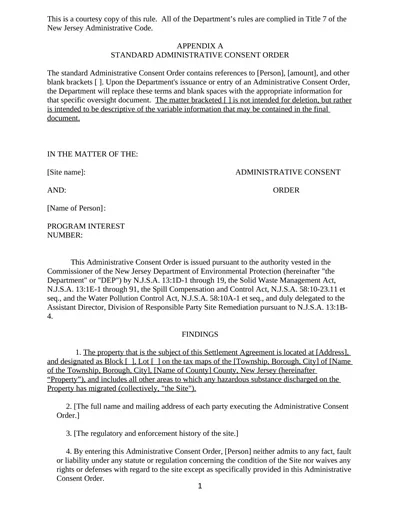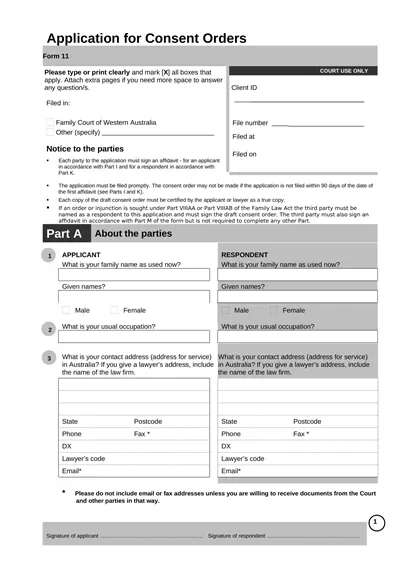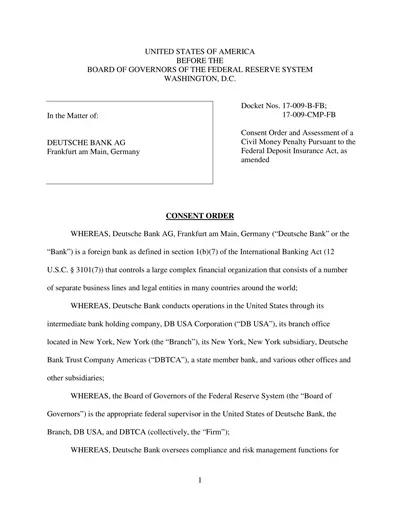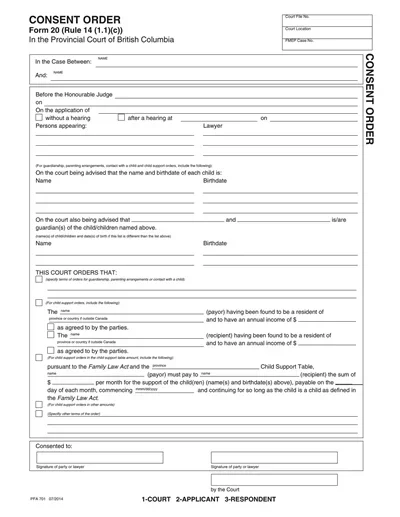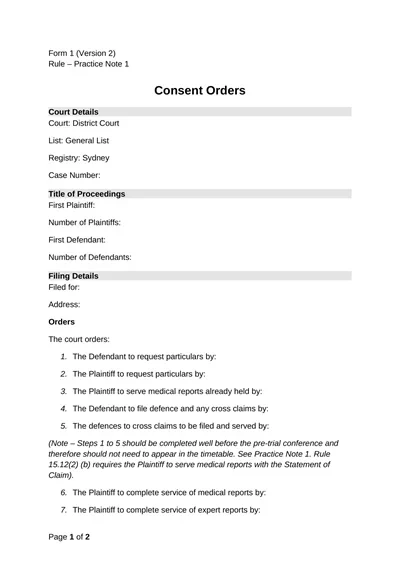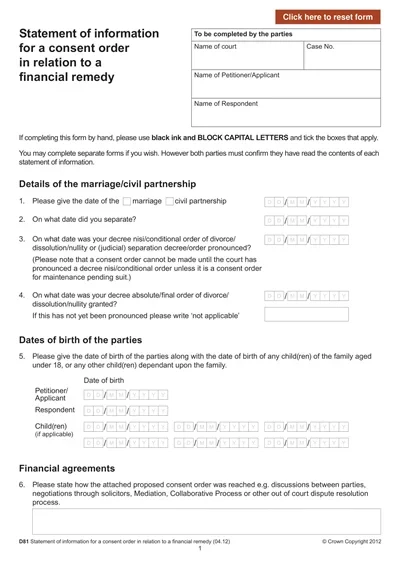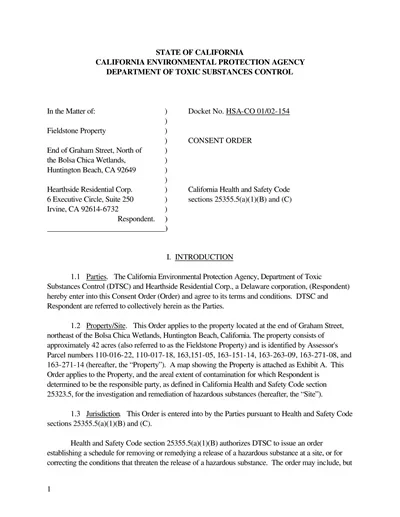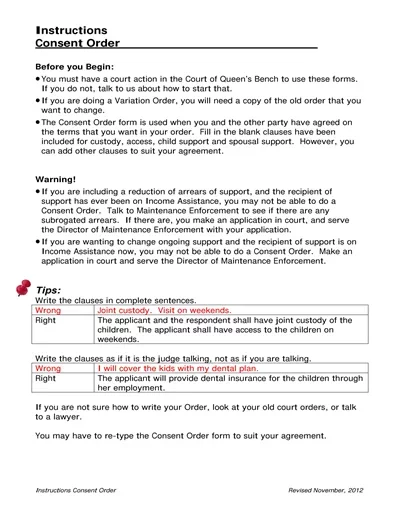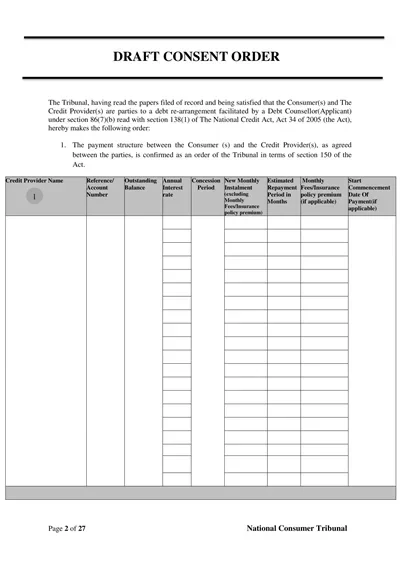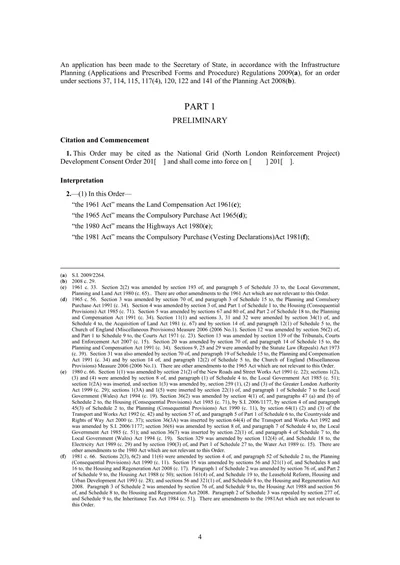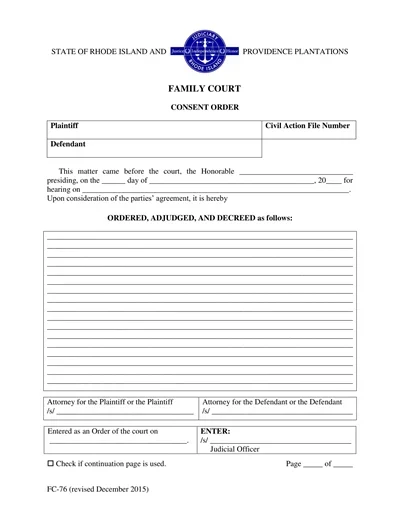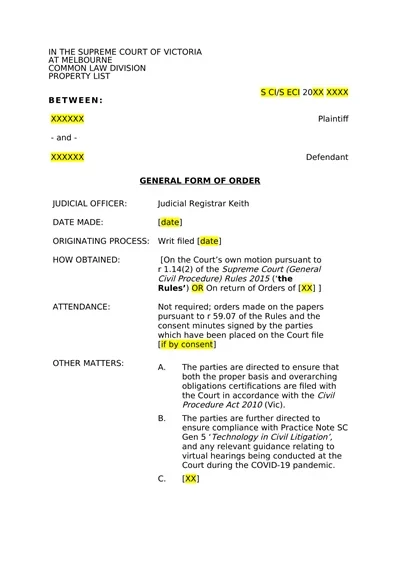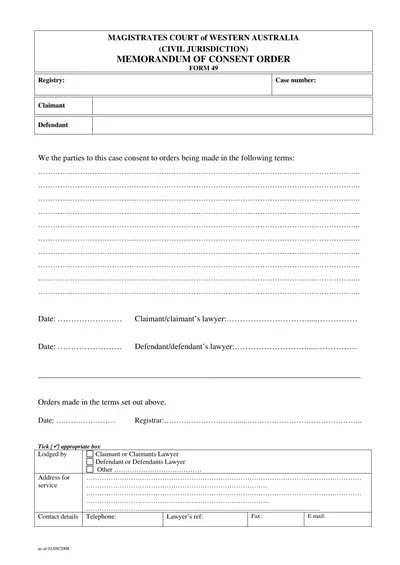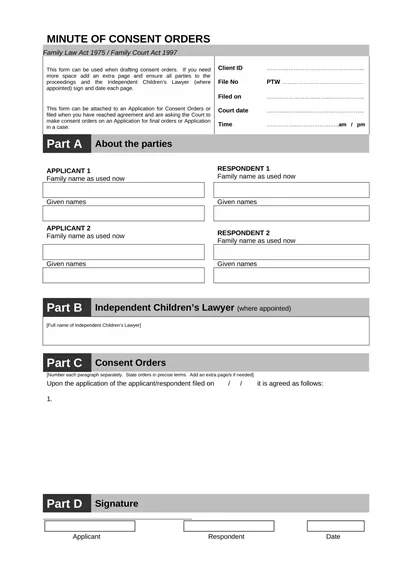28+ Free Sample Consent Order Templates (WORD, PDF)
A Consent Order Template is a legally binding document used by parties in a dispute or agreement, commonly in family law matters such as divorce or child custody arrangements. It outlines the terms of an agreement between the parties, explicitly detailing how assets will be divided, any financial arrangements agreed upon, and the terms relating to the care and support of any children involved.
Once both parties have agreed to the terms set out in the template and the terms have been reviewed and approved by a court, the consent order becomes enforceable. This document serves as a protective measure, ensuring both parties adhere to their agreed commitments and providing a clear legal framework to resolve potential disputes in the future.
Download Free Sample Consent Order Templates
What is a Consent Order?
A Consent Order is a legal document that records the agreement between parties in a dispute, especially within family law contexts like divorce or separation, and receives the court’s approval to make it legally binding. This document typically outlines the terms regarding financial arrangements, property distribution, and, if applicable, child custody and support.
The critical aspect of a Consent Order is that it is mutually agreed upon by both parties, negating the need for a contested hearing. However, for it to be effective, it must be approved by the court, ensuring that the terms are fair and just for all involved, especially for children affected by the arrangement. Consent Orders carry the same legal weight as a court order made after a hearing, making them enforceable by law, thereby offering a sense of security and finality to the parties involved.
Reasons to Consider a Consent Order
A consent order is a legal document that records an agreement between two parties in a dispute, particularly in family law matters such as divorce or child custody arrangements. There are several compelling reasons to consider obtaining a consent order:
Legally Binding
A vital advantage of a consent order is that it is legally binding. This means that once a court approves it, both parties are legally obliged to adhere to the terms set out in the order, providing security and predictability for both parties involved.
Clarity and Certainty
Consent orders provide clarity and certainty regarding the obligations of each party. The terms are clearly defined, reducing the likelihood of future disputes over misunderstandings or disagreements in interpreting the agreement.
Cost-Effective
Reaching an agreement through a consent order can be significantly more cost-effective than going through a court battle. Lengthy court proceedings can be expensive, not to mention emotionally draining for both parties.
Time-Saving
Consent orders can save considerable time compared to the potential duration of court proceedings. Once an agreement is reached, it can be made into a consent order relatively quickly, allowing both parties to move forward.
Flexibility
Consent orders offer flexibility that might not be possible in a court-imposed decision. Parties can negotiate terms that precisely suit their needs and circumstances if the agreement is fair and in the children’s best interest.
Finality
Once a consent order is made, it brings a sense of finality to the matter. It can only be changed in minimal circumstances, helping both parties avoid ongoing disputes and making them plan for the future more accurately.
Critical Components of a Consent Order
A Consent Order is a legally binding agreement approved by a court, often used in divorce or family law to resolve financial or custody disputes without going to trial.
Key components include:
- Parties’ Information: Full names and details of all parties involved.
- Recitals: Brief description of the background and intentions behind the agreement.
- Terms of Agreement: Detailed outline of the division of assets, property, debts, and any spousal or child support arrangements.
- Parenting Arrangements: If applicable, specifics about custody, visitation rights, and child support.
- Duration and Modification: Terms regarding how long the order will remain in effect and under what circumstances it can be modified.
- Signatures: Sign-offs by all parties involved and their legal representatives, signifying consensus.
- Court Approval: Finally, the document requires validation and approval by a judge to become enforceable.
Benefits of a Consent Order
A Consent Order, especially in divorce or family law, carries significant benefits. It provides a legally binding resolution to financial matters, ensuring that both parties adhere to the agreed-upon terms, thus minimizing future conflicts. This legal decree safeguards assets, pensions, and properties, granting peace of mind to both parties.
Additionally, a Consent Order facilitates a clear pathway for the enforcement of the agreement should any disputes arise post-divorce, posing a deterrent against non-compliance. Setting financial arrangements into a formal legal framework offers closure to both parties, allowing them to move forward with their lives with defined financial obligations and rights.
How to Write a Consent Order Template
Writing a consent order requires careful consideration and clarity to ensure all parties understand and agree to the terms outlined. Below are detailed steps to create an effective consent order template:
1. Title and Introduction
- Start with a title specifying the document’s nature, such as “Consent Order.”
- Include an introductory paragraph specifying the parties involved, the date, and the purpose of the consent order.
2. Recitals
- Background Information: Briefly describe the case or matter leading to the consent order.
- Acknowledgement: Acknowledge that both parties have agreed to the terms voluntarily.
3. Terms and Conditions
- Detailed Descriptions: Clearly describe each term and condition the parties have agreed upon. Use numbered or bulleted lists for clarity.
- Responsibilities and Obligations: Specify the duties and obligations of each party in detail.
- Duration: State the period for which the consent order is valid.
4. Dispute Resolution
- Process: Outline the process to be followed in case of any disputes arising from the consent order.
- Mediation and Arbitration: Include clauses for mediation or arbitration, if any.
5. Signatures
- Leave space for all parties’ signatures, including the date of signing, to formalize the consent order.
6. Appendices (if necessary)
- Supporting Documents: Attach any documents or agreements referenced in the consent order.
- Glossary: Include a glossary of terms for any legal or technical language used in the document.
By following these steps and sub-steps, you can draft a comprehensive and transparent consent order template that serves the needs and agreements of all parties involved.

